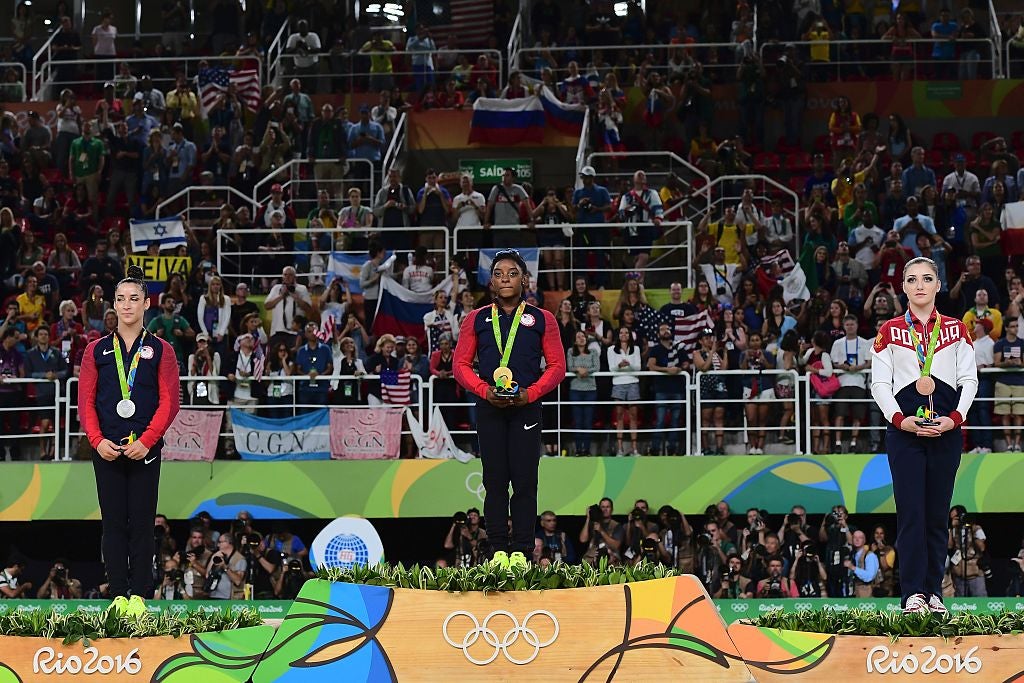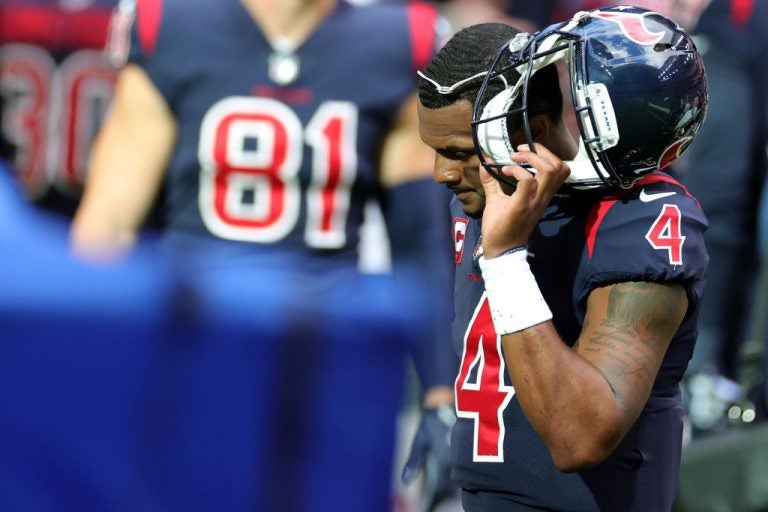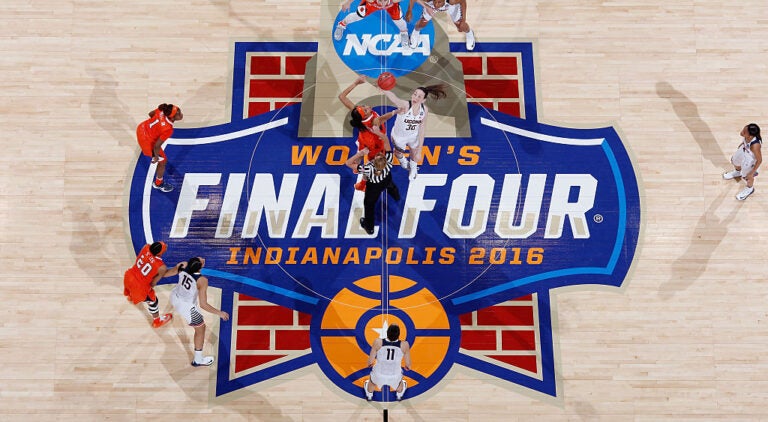Gymnast Alliance Movement Challenges Women’s Gymnastics Culture, But We Must Be Ready to Listen to Survivors
Why this matters
Sports media is reminded of the abuse facing gymnasts during Olympic years or during big trials, but during the past two years gymnasts across generations like Simone Biles, Valentine Sabatou and Louise McCorgan have come forward to share their stories. Researcher and former gymnast Natalie Barker-Ruchti brings insight into their process and how the sports world can support them going forward.
Since the release of the documentary Athlete A in June 2020, hundreds of women’s gymnasts have taken to social and other media to speak out about the abuse they experienced as gymnasts. Using the hashtag #gymnastalliance, their statements have resulted in an international call for the cultural transformation of women’s gymnastics.
As a former gymnast, gymnastics coach, and critical sociological researcher of women’s artistic gymnastics, I have keenly followed the #gymnastalliance movement. Could worldwide cultural change, after decades of suppressing and hurting gymnasts, be possible?
The 2020 Tokyo Olympic Games offered some hopeful signs. Simone Biles’ self-initiated withdrawal from the all-around team final to protect her health and well-being and German gymnasts’ decision to wear unitards to fight the sexualization of athletes are unprecedented examples. They point to a different kind of women’s gymnastics, one characterized by gymnast agency and gymnast voice on a global scale.
Yet we cannot assume that abuse belongs to the past. As gymnast advocate Rachael Denhollander, a victim herself of sexual abuse at the hands of former USA Gymnastics team doctor Larry Nassar, reminds us, abuse continues to happen across the world in the sport. In America, the lawsuit filed against USA Gymnastics could be nearing a $425 million settlement as advocates like Aly Raisman and Biles continue to speak out against the organization and about their abuse.
We must continue to listen to and take seriously those speaking out about abuse to mend what's broken in the sport and chart a better future.
Listening to women gymnasts
Through qualitative research interviews, I have during recent months recorded former gymnasts’ experiences of speaking out about abuse. The 18 women I have spoken with are 21 to 50 years old, come from 12 countries on four continents, and have competed in women’s gymnastics across all levels. The interview data offer insight into why, when, and how gymnasts speak out about abuse, the reactions they receive, and the meaning they gain from speaking out.
Speaking out about abuse should not be understood as a singular event such as posting a tweet or making a complaint. Rather, these women said that “speaking out” entails a lengthy process of confronting and processing abuse. They document the type of abuse suffered, the time since and the potential healing from the abuse, the proximity to the gymnastics community, and the support they may or may not have received from their country.
In interviewing these survivors, I found four steps materialized as the core components of “speaking out” against abuse:
- 1. Reconstructing and validating abuse experiences
- 2. Informing individuals important to them
- 3. Making a statement about abuse
- 4. Managing reactions from speaking out
Reconstruction and validation were, according to the interviewees, the most important part of the speaking-out process. This comprised several components and could be spread across as many as three years.
They understood that speaking out through social or other media could put the spotlight on very personal experiences. The spotlight could also implicate them in a contentious discussion, as many coaches and observers still believe that tough/abusive coaching is necessary for elite sporting success. Gymnastics stakeholders and the public could discredit their experiences. Understanding the stress a public statement about abuse could cause, many interviewees said they were concerned with protecting their health, well-being, and future professional prospects. The interviewees were further cognizant of the effects a public statement could have on loved ones, especially their parents. Still, the interviewees described that they could not stay silent like so many others had done. They felt a responsibility toward gymnasts currently in abusive coach-gymnast relationships.
"I’ve asked myself for a long time why nobody else had spoken out for us - for me - when I was there [at the gym]. So then it seems logical, fighting for all the people who are still there."
"If the currency of [perpetrators] is silenced, then I need to create the opposite currency to overcome their offending."
For former gymnasts who had had their complaints dismissed earlier, the reason to speak out was to take back control:
"I wanted to show that I was not afraid to say what had happened and actually own it … it [the abuse] isn’t a shameful thing to carry or to bear. To kind of take that control back and feel like it’s mine, saying on my terms how it happened."
Reconstruction and validation were painstaking but necessary for the account of the abuse. This was described as necessary because the survivors sometimes had shut out the abuse experiences - some for as long as 30 years - and either did not trust their memories or experienced stress-related memory impairment. Getting it right was crucial for them; they did not want to make or be criticized for making false allegations. Putting the abuse on paper was further important because it helped them facilitate their processing of the abuse.
"It was a necessary step in order to process it [the abuse] and move on with my life."
To delve into their memories, the interviewees described reading old diary entries, speaking with people who had witnessed the abuse (such as parents, non-abusive coaches, and teammates), following the statements that were emerging from other gymnasts through the USA Gymnastics sex abuse scandal and the #gymnastalliance movement, and even consulting child abuse literature.
Related: Gendered Violence Cases Challenge Sports Journalists To Consider And Reconsider Each Word They Write
What the reconstruction of abuse achieved was confirmation and validation of their experiences. While stressful, this gave them confidence to go forward speaking out. But doing so was not without challenges.
"This process took courage … because … everything …. everything comes back to the surface."
The desire to inform individuals important to them further highlights the care former gymnasts took in processing their abuse. Concern for parents was particularly acute, because mostly they were unaware of their children’s abuse experiences.
And for several of the interviewees, the concern was justified. Parents blamed themselves for not protecting their daughters, and the insight complicated family relationships.
For some, informing parents before making a public statement about abuse was not an option.
"I had to tell the truth. To me, that was an intrinsic part of the story. … So I took the approach of doing something and apologizing later. I just found it too hard [to speak to my parents], because I knew if my parents had said no, I wouldn’t have done it. And I didn’t want to not do it."
Additionally, interviewees often formally told coaches who had not adopted abusive behaviors and practices of their abuse. It was important to the interviewees that these coaches knew that their statement about abuse did not relate to them. The interviewees also spoke with teammates to prepare them for potentially negative public backlash. For all interviewees, these conversations were a precursor to all other means of speaking out.
Making a statement about abuse happened in a variety of ways, including through social media; interviews with journalists; hearings with coaches and gymnastics organizations; statements in complaints processes; and reports filed to police and other safeguarding organizations. For six of the interviewees, my research was the only means (so far) of speaking out.
The interviewees’ disclosures described various categories of abuse – including physical, psychological, and sexual abuse as well as physical and psychological neglect – in addition to the consequences they have suffered because of it.
Before making a statement, the survivors carefully considered whether to name perpetrators and bystanders. Most decided to omit names. Their motivation was not to denunciate individuals, but to point to cultural and organizational problems that require transformation to prevent abuse.
The interviewees agreed that making a public statement was a major distressing event.
"It was terrible. I ended up with tachycardia. I went back to being a girl [she had developed tachycardia in response to the abuse she had suffered as a child gymnast] … but I understood that I had to go through the hurricane again because of exposing everything."
Speaking out through hearings and complaints processes and filing police reports were also taxing, mainly because the information survivors provided was often discredited or even dismissed. For several, their report did not result in any consequences for perpetrators or clubs.
This research interview was seen by many of the women as the most non-threatening way to come forward. It offered anonymity and did not risk discrediting or dismissal. Some of the interviewees have also reported that the interview supported their healing process.
Related: Gymnast Vera Caslavska's Silent Protest Spoke Volumes
Lastly, for most survivors, managing reactions to speaking out is ongoing. Those who made a statement through social and other media have received, and continue to receive, an abundance of positive reinforcement through compassionate and inspirational messages. As much as possible, the interviewees interacted with the authors of the messages.
Reactions were also distressing.
"I didn’t like that feeling. It [e.g., a newspaper article; reaction to a social media post] appears suddenly, and other people react to it. You don’t have any control over it. It [people’s negative reactions] can really sound like a personal attack."
What the interviewees found most disappointing was the discrediting of their statements by stakeholders from the gymnastics community.
"I was outraged and disappointed. Because there are so many of us in [her country] who have spoken out. There are so many of us who went to the federation and who spoke to the coaches. And they're now acting as if none of it is true and as if they didn’t know anything about it."
The reaction was experienced as a dismissal, a treatment that took them back to how the coaches and gymnastics officials had regarded them as gymnasts.
Some of the interviewees described having received threats and/or feeling threatened.
"They [critics] found my home address. They contacted former teammates to get my mobile number. They had my email address. They were sending me messages via Instagram. They sent my parent a threatening letter at their work. … It just got really bad really quickly."
Understanding the experiences and statements of women gymnasts
At this early point of data analysis, I would like to put forward three important observations:
First, speaking out about abuse is a lengthy process of confronting and processing abuse that can result in a range of public statements. Such statements about abuse are not spur-of-the-moment reactions, but are preceded by meticulous reconstruction and validation of abuse experiences and careful consideration of why, when, and how to speak out.
Second, from the beginning of the process, an important reason for confronting and processing the abuse is to protect current and future gymnasts. While it was important to the interviewees to go through the speaking-out process on their terms, their motivation to do so was to better women’s gymnastics and to prevent abuse. They wanted to heal – and to help their fellow gymnasts heal as well. They did not come forward publicly to gain attention or to be vindictive toward gymnastics organizations or stakeholders.
Third, the speaking-out process was for the 18 interviewees part of a meaningful healing journey. While their healing is not complete, and may never be complete, the process provided important confirmation that their experiences were experiences of abuse. It was not something they had misinterpreted or imagined. While constructing these accounts was taxing, it afforded clarity. Making a public statement offered positive reactions such as solidarity and hope. While none of them would have chosen the speaking out experience voluntarily, the interviewees recognized that it offered meaningfulness.
"And, well, apparently my daughter, Larry Nassar’s exposure, the need to expose … the planets aligned so that I would be going through what I’m living. It’s beautiful and, having gone through that torment, also makes me who I am today. So, if I had stayed in the past, I wouldn’t have evolved as a person, so I needed to solve that and be smart and capitalize on that [the abuse experience] to be able to pass it on to the gymnasts I’m coaching today."
By having gone through the speaking out process, this former gymnast, after 30 years of shutting out her past and detaching herself from the gymnastics community, has been able to meaningfully return to the sport.
The accounts of the 18 former gymnasts touched me. These women, as with hundreds of others who have spoken out about abuse in recent years, have courageously accepted and processed their experiences for the benefit of current and future generations of gymnasts. This selflessness is honorable and calls for action from gymnastics stakeholders, coaches, parents, journalists, fans, and others impacted by or participating in sport.
Listen to and take seriously statements of abuse. Be sure to understand the efforts and meanings that lie behind making such statements. And help contribute in whatever ways possible to transforming women’s gymnastics toward a future free of abuse.
Natalie Barker-Ruchti, PhD, is an associate professor at the School of Health Sciences at Örebro University in Sweden.
Monthly Issue
The Athlete's Journey
If you are what you repeatedly do, what happens when you stop doing it?
The athlete's journey outside of competition is not often covered in media, nor considered all that much by fans. It can, however, be core to athletes’ lived experiences, impacting decisions on where to play, which business opportunities to take, how to take care of their physical and mental health and more.




